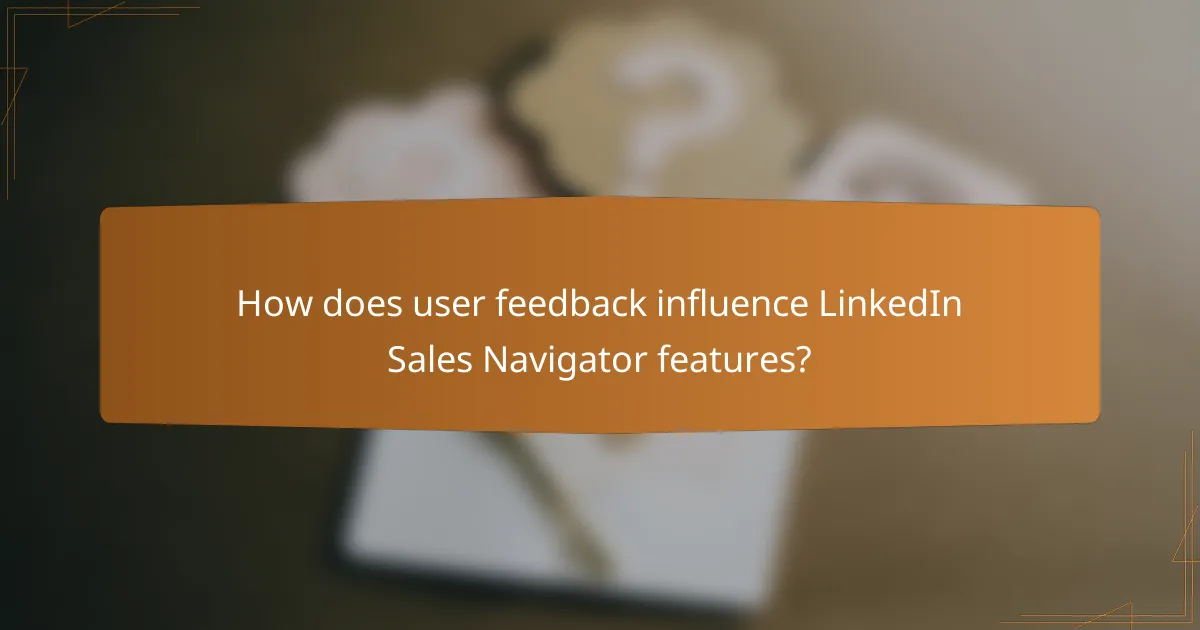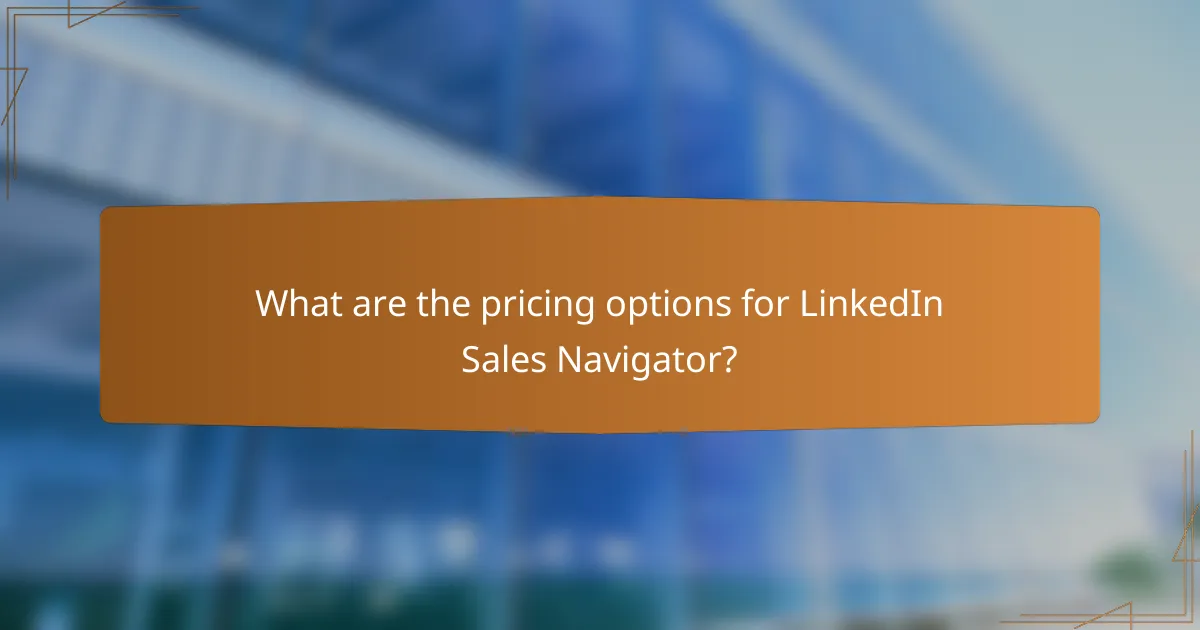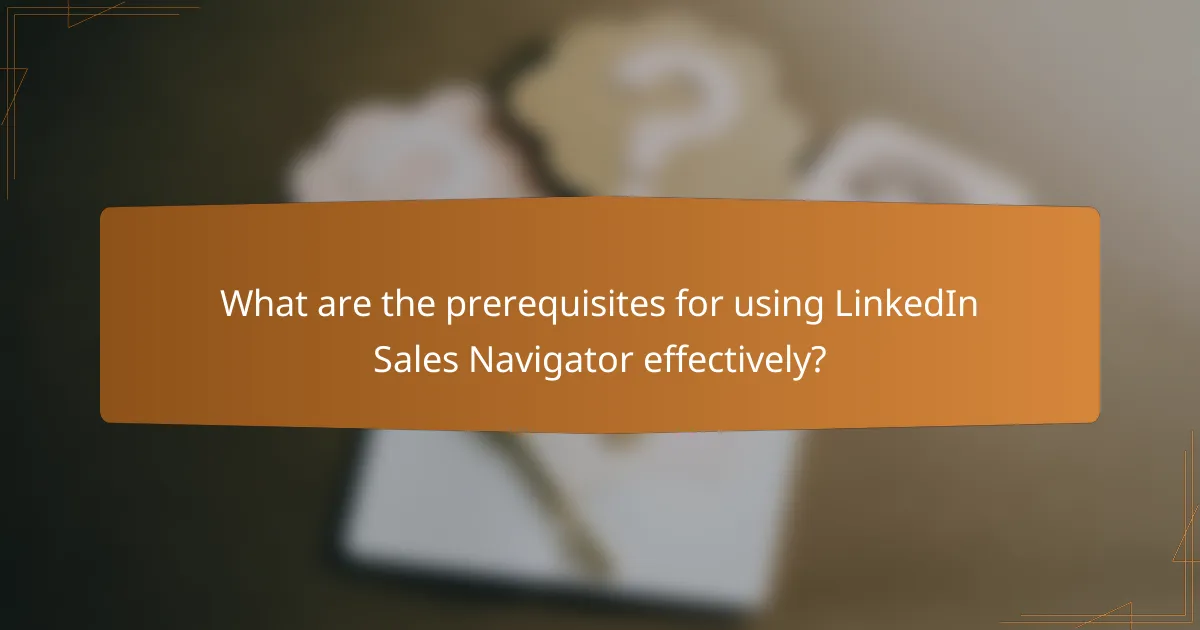LinkedIn Sales Navigator is a powerful tool designed to enhance lead generation by enabling sales professionals to effectively identify and connect with potential clients. While many users praise its advanced features for targeting and engagement, feedback also reveals challenges related to usability and integration. Understanding these user insights is essential for LinkedIn to continually improve the platform and better serve the needs of sales teams.

How does LinkedIn Sales Navigator improve lead generation?
LinkedIn Sales Navigator enhances lead generation by providing advanced tools for identifying and connecting with potential clients. Its features allow sales professionals to target the right audience, engage effectively, and streamline their sales efforts.
Enhanced targeting capabilities
Sales Navigator offers sophisticated targeting options that enable users to filter leads based on various criteria such as industry, company size, and geographic location. This precision helps sales teams focus their efforts on high-potential prospects, increasing the likelihood of successful outreach.
For example, a user can search for decision-makers in the technology sector within a specific city, narrowing down their leads to a manageable list. This targeted approach often results in higher conversion rates compared to broader strategies.
Increased engagement with prospects
The platform facilitates deeper engagement with prospects through personalized messaging and insights into their activities. Users can see when prospects change jobs, share content, or engage with their network, allowing for timely and relevant outreach.
By leveraging these insights, sales professionals can craft tailored messages that resonate with their audience, improving response rates. Regularly engaging with prospects through thoughtful interactions can foster relationships that lead to sales opportunities.
Streamlined sales processes
LinkedIn Sales Navigator integrates seamlessly with CRM systems, allowing for efficient tracking of interactions and lead management. This integration helps sales teams maintain organized records and follow up on leads without missing opportunities.
Additionally, the platform’s lead recommendations and alerts keep users informed about potential opportunities, ensuring that they can act quickly. By automating routine tasks, sales professionals can focus more on building relationships and closing deals.

What are the key user feedback trends for LinkedIn Sales Navigator?
User feedback trends for LinkedIn Sales Navigator highlight a mix of positive experiences and common challenges. Many users appreciate its robust features for lead generation and relationship management, while others face difficulties with usability and integration.
Positive user experiences
Users frequently commend LinkedIn Sales Navigator for its advanced search capabilities, which allow for precise targeting of potential clients. The ability to filter leads based on various criteria, such as industry and company size, enhances the effectiveness of outreach efforts.
Additionally, the integration with CRM systems is a significant advantage, enabling seamless data transfer and management. Many users report increased productivity and improved sales outcomes as a result of utilizing the platform’s features effectively.
Common challenges faced by users
Despite its strengths, some users encounter challenges with the platform’s interface, citing a steep learning curve for new users. Navigating through the various features can be overwhelming, particularly for those unfamiliar with sales tools.
Another common issue is the pricing structure, which some users find to be on the higher side compared to alternatives. This can be a barrier for smaller businesses or startups looking to leverage LinkedIn Sales Navigator for their sales strategies.

How does user feedback influence LinkedIn Sales Navigator features?
User feedback plays a crucial role in shaping the features of LinkedIn Sales Navigator. By actively listening to users, LinkedIn can enhance functionality, improve user experience, and prioritize tools that meet the evolving needs of sales professionals.
Feature enhancements based on user input
LinkedIn regularly collects feedback through surveys, user forums, and direct interactions to identify areas for improvement. This input leads to specific feature enhancements, such as improved search filters or more intuitive user interfaces, which directly address user pain points.
For example, if users express difficulty in finding leads, LinkedIn may enhance the search algorithm or add new filtering options. These enhancements are typically rolled out in updates, ensuring that the platform evolves in line with user needs.
Prioritization of user-requested tools
LinkedIn prioritizes the development of tools that users request most frequently. This approach ensures that resources are allocated to features that will have the greatest impact on user satisfaction and productivity.
For instance, if a significant number of users request integration with CRM systems, LinkedIn may expedite the development of that feature. This prioritization helps maintain user engagement and loyalty, as clients see their suggestions being implemented.

What are the pricing options for LinkedIn Sales Navigator?
LinkedIn Sales Navigator offers flexible pricing options tailored to different user needs, primarily through monthly and annual subscriptions. Understanding these options can help you choose the plan that best fits your sales strategy and budget.
Monthly subscription costs
The monthly subscription for LinkedIn Sales Navigator typically ranges from approximately $80 to $100 per month, depending on the specific plan selected. This option is ideal for individuals or teams that prefer short-term commitments or need the service for a limited time.
When opting for a monthly plan, consider that the costs can add up quickly if you intend to use the service for an extended period. Evaluate your usage patterns to determine if a monthly subscription aligns with your sales goals.
Annual subscription discounts
LinkedIn offers significant discounts for annual subscriptions, which can reduce the monthly cost to around $70 to $80 per month when billed annually. This option is beneficial for users who plan to use Sales Navigator long-term, as it can lead to substantial savings over time.
When choosing an annual subscription, be aware of the upfront payment requirement. Ensure that your sales strategy justifies the investment, as the annual plan locks you in for a full year. Consider your team’s growth and sales projections to make an informed decision.

How do users perceive the value of LinkedIn Sales Navigator?
Users generally perceive LinkedIn Sales Navigator as a valuable tool for enhancing sales prospecting and lead generation. Its ability to provide targeted insights and advanced search capabilities helps sales professionals connect with potential clients more effectively.
Return on investment metrics
Return on investment (ROI) for LinkedIn Sales Navigator can vary significantly based on user engagement and industry. Many users report achieving a ROI of 5x to 10x, particularly when utilizing the platform’s advanced filtering and lead recommendations effectively.
To maximize ROI, users should track metrics such as the number of leads generated, conversion rates, and the time saved in prospecting. Regularly assessing these metrics can help identify which features yield the best results.
User satisfaction ratings
User satisfaction ratings for LinkedIn Sales Navigator tend to be positive, with many users appreciating its robust features and user-friendly interface. Ratings often range from 4 to 4.5 out of 5 stars across various review platforms.
However, some users express concerns regarding the cost, particularly for small businesses. To improve satisfaction, users are encouraged to take advantage of trial periods and explore all features before committing to a subscription.

What are the alternatives to LinkedIn Sales Navigator?
Several alternatives to LinkedIn Sales Navigator provide similar functionalities for sales prospecting and lead generation. These options can vary in features, pricing, and target audiences, making it essential to evaluate each based on specific business needs.
ZoomInfo as a competitor
ZoomInfo is a robust competitor to LinkedIn Sales Navigator, offering extensive databases of business contacts and companies. It provides detailed insights into organizations, including financials, employee counts, and technology stacks, which can enhance lead targeting.
One key advantage of ZoomInfo is its data accuracy, which is often cited as a strong point. Users can access advanced search filters and segmentation tools, allowing for highly tailored outreach strategies. Pricing typically ranges from hundreds to thousands of dollars per month, depending on the level of access and features required.
HubSpot Sales Hub comparison
HubSpot Sales Hub serves as another alternative, integrating sales tools with customer relationship management (CRM) capabilities. This platform is particularly beneficial for businesses already using HubSpot’s marketing tools, as it allows for seamless data sharing and workflow automation.
While HubSpot Sales Hub may not have the same depth of lead data as LinkedIn Sales Navigator, it excels in user-friendly features such as email tracking and pipeline management. Pricing varies, with options available for free and paid tiers that can cost from $50 to several hundred dollars per month, depending on the features selected.

What are the prerequisites for using LinkedIn Sales Navigator effectively?
To use LinkedIn Sales Navigator effectively, users should have a clear understanding of their target audience and set specific sales goals. These prerequisites help in maximizing the platform’s features and tailoring outreach strategies to achieve better results.
Understanding target audience
Identifying your target audience is crucial for leveraging LinkedIn Sales Navigator. This involves defining key demographics such as industry, company size, job titles, and geographic locations. By narrowing down your audience, you can create more personalized and relevant outreach efforts.
Utilize the advanced search filters in Sales Navigator to segment your audience effectively. For instance, you can target decision-makers in technology companies within the EU, which can significantly enhance your engagement rates. Regularly updating your audience criteria based on market trends is also beneficial.
Setting clear sales goals
Establishing clear sales goals is essential for measuring success with LinkedIn Sales Navigator. Goals should be specific, measurable, achievable, relevant, and time-bound (SMART). For example, aim to connect with a certain number of leads each month or increase your response rate by a specific percentage.
Consider breaking down larger goals into smaller, actionable steps. This could include daily or weekly outreach targets, follow-up schedules, and tracking engagement metrics. Regularly reviewing and adjusting these goals based on performance can help maintain focus and drive results.

How can businesses optimize their use of LinkedIn Sales Navigator?
Businesses can optimize their use of LinkedIn Sales Navigator by leveraging its advanced search features, personalized outreach tools, and analytics to enhance lead generation and relationship building. Understanding how to effectively use these tools can significantly improve sales outcomes.
Utilizing Advanced Search Features
LinkedIn Sales Navigator offers advanced search capabilities that allow businesses to filter leads based on various criteria such as industry, company size, and location. This targeted approach helps in identifying the most relevant prospects, increasing the chances of successful engagement.
To maximize this feature, create specific buyer personas and use them to guide your searches. For example, if targeting small businesses in the tech sector, set filters accordingly to focus your efforts on the most promising leads.
Personalizing Outreach Efforts
Personalization is key in outreach efforts using LinkedIn Sales Navigator. By utilizing insights from a prospect’s profile, such as shared connections or interests, businesses can craft tailored messages that resonate more with potential clients.
Consider using templates that allow for customization based on the recipient’s background. A personalized message can significantly increase response rates, making it essential to invest time in researching each lead before reaching out.
Leveraging Analytics for Improvement
Sales Navigator provides analytics that can help businesses track engagement and measure the effectiveness of their outreach strategies. By regularly reviewing these metrics, companies can identify what works and what needs adjustment.
Focus on key performance indicators such as connection requests accepted, response rates, and engagement levels. This data-driven approach allows for continuous improvement and helps refine sales tactics over time.


